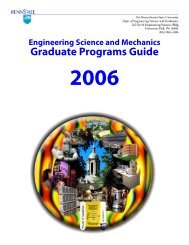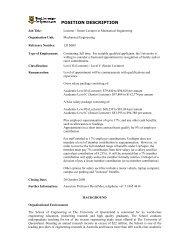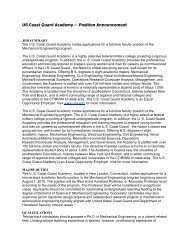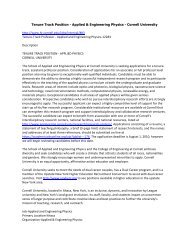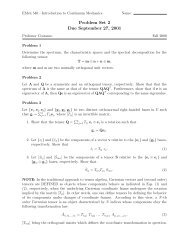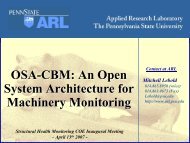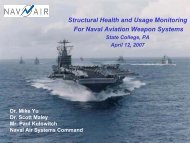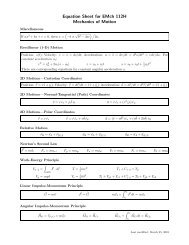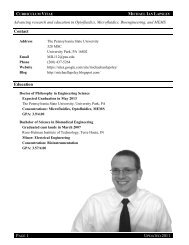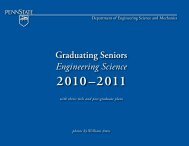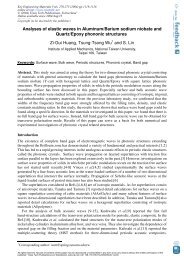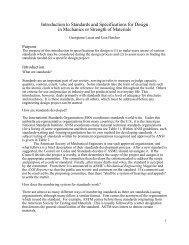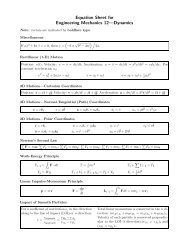Miniaturisation for chemistry, physics, biology, & bioengineering
Miniaturisation for chemistry, physics, biology, & bioengineering
Miniaturisation for chemistry, physics, biology, & bioengineering
You also want an ePaper? Increase the reach of your titles
YUMPU automatically turns print PDFs into web optimized ePapers that Google loves.
Fig. 3 SSAW-based cell patterning. (a) Patterning of bRBC. The wavelength of the applied SAW was 100 mm. (b) Patterning of E. coli cells pretreated<br />
with Dragon Green fluorescent dyes. The wavelength of the applied SAW was 300 mm (see Supplementary Video 2, ESI†). I IV shows the dynamic<br />
process of E. coli cells aggregate at a pressure node. (c–f), Flow cytometric histograms (DiBAC4(3) fluorescent light intensity (FI) vs. <strong>for</strong>ward scattering<br />
(FS)) <strong>for</strong> different cell types. (c) E. coli cells cultured <strong>for</strong> 12 h (Positive Control 1); (d) E. coli cells that passed through a microchannel without applying<br />
SSAW (Positive Control 2); (e) E. coli cells that experienced the SSAW-based patterning process in a microchannel (SSAW Sample); and (f) E. coli cells<br />
heated at 70 C <strong>for</strong> 30 min (Negative Control).<br />
reached the pressure nodes, the acoustic pressures, and thus<br />
acoustic <strong>for</strong>ces applied to the cells, were nearly zero; cells were<br />
steadily patterned in the ‘‘wells’’ defined by the pressure gradients<br />
around the pressure nodes. At the same time, the pressure<br />
oscillations inside the patterned cells (at pressure nodes) are also<br />
nearly zero, minimizing the heat generation. These characteristics<br />
suggest that the ‘‘acoustic tweezers’’ technique would be noninvasive<br />
to cells.<br />
In order to confirm the non-invasive nature of our technique,<br />
we studied the integrity of the cell membranes be<strong>for</strong>e and after<br />
the patterning process. We used a membrane-potential-sensitive<br />
dye, DiBAC 4(3) (bis-(1,3-dibarbituric acid)-trimethine oxanol),<br />
as an indicator <strong>for</strong> cell viability. DiBAC 4(3) is an anionic lipophilic<br />
fluorescent dye which is found mainly in the outer<br />
cytoplasmic membranes of intact cells. 47 It enters the cell body<br />
and accumulates in the cytoplasm when the cell membrane is<br />
damaged. Thus, the amount of dye accumulation, which is<br />
indicated by the average fluorescent intensity (FI), can be used to<br />
quantify the degree of membrane disruption caused by our<br />
technique. We per<strong>for</strong>med flow cytometry experiments to quantitatively<br />
analyze the viability of cells, in which FI and the<br />
<strong>for</strong>ward scattering (FS) signals represented the cell viability and<br />
size distribution, respectively. 53 As shown in Fig. 3c–e, the E. coli<br />
cells after the SSAW patterning process (average FI ¼ 0.536;<br />
Fig. 3e) exhibited distribution peaks almost identical to those of<br />
the cells prior to the pattering process (positive controls of<br />
average FI ¼ 0.530–0.536; Fig. 3c and 3d). On the other hand,<br />
the cells incubated at 70 C <strong>for</strong> 30 min (negative control; Fig. 3f)<br />
exhibited a much higher FI (2.2), implying that the cell<br />
membranes were severely damaged. These results (as detailed in<br />
Supplementary Table 1, ESI†) confirm that our SSAW-based<br />
‘‘acoustic tweezers’’ technique is non-invasive.<br />
Quantitative <strong>for</strong>ce analysis<br />
The behavior of cells or other objects in a SSAW field can be<br />
predicted via theoretical <strong>for</strong>ce analyses. The primary <strong>for</strong>ces<br />
involved in the SSAW patterning process are as follows: (1)<br />
acoustic radiation <strong>for</strong>ces; 35,44–47,49 (2) viscous <strong>for</strong>ces; (3) buoyant<br />
<strong>for</strong>ces; and (4) gravity. Among these <strong>for</strong>ces, buoyant <strong>for</strong>ces are<br />
typically balanced by gravitational <strong>for</strong>ces as they are of similar<br />
magnitudes and in opposite directions. Fig. 4a shows the<br />
dependence of these <strong>for</strong>ces on particle size. It reveals that when<br />
the diameters of the particles are >1 mm, acoustic <strong>for</strong>ces dominate<br />
under the applied power intensity. Fig. 4b shows that when<br />
the SAW wavelength is smaller than 100 mm, the acoustic <strong>for</strong>ces<br />
acting upon the targets (polystyrene beads with diameter of<br />
1.9 mm, bRBC, and E. coli cells) are significantly stronger than<br />
the viscous <strong>for</strong>ces. In this study, all the particles were trapped at<br />
the pressure node, where the acoustic <strong>for</strong>ce was minimal and<br />
particles were immobilized due to the <strong>for</strong>ce gradient around the<br />
pressure node. Fig. 4c shows the acoustic <strong>for</strong>ce distribution<br />
within a half wavelength region centered at a pressure node. The<br />
results show that the acoustic <strong>for</strong>ces change sinusoidally and<br />
point to the pressure node, <strong>for</strong>ming a trapping well (inset of<br />
Fig. 4c). To release a particle from the trapping well, one must<br />
This journal is ª The Royal Society of Chemistry 2009 Lab Chip, 2009, 9, 2890–2895 | 2893



